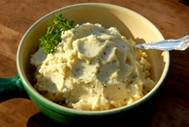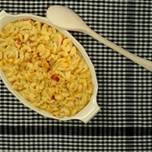With the right ingredient swapping, you can indulge in most of your favorite foods without suffering the consequences. Here we share some healthy swaps for user-friendly tips and tricks to transform high-carb indulgences into healthy dishes that won’t send your sugar soaring. Sometimes you can switch out an ingredient and not even notice the difference. Other times, simply adding an extra healthy food to your dish is a great way to increase the nutrition quotient without giving up all that is yummy. For instance:
Mashed Potatoes Swap

To have comforting, creamy, mashed potatoes without chalking up 35 grams of carbs in a one-cup serving, try this half and half strategy. Use half the amount of potatoes you want for your dish.
A medium potato contains about 33 grams of carbs and 3 grams of fiber per cup. Then use an equal amount of either turnips (about 8 grams of carbs and 3 grams of fiber per cup), rutabaga (about 15 grams of carbs and 3 grams of fiber per cup), cauliflower (about 3 grams of carbs and 2 grams of fiber per cup) or some combination of the three. Boil or microwave the potatoes and vegetables, and mash these up together. Add a mixture of one-half softened butter and one-half healthy, trans-free, vegetable oil spread. Then, warm some cream or half-and-half in the microwave, and beat in until smooth. Salt and pepper to taste. For extra flavor, add minced garlic (raw or gently cooked) to the butter mixture, or mix in some grated parmesan, romano, or asiago cheese.
Cauliflower Mac & Cheese

Cauliflower is a great substitute for white noodles and white rice, because of its color, versatile texture, and because cauliflower is a member of that ultra-healthy family of cruciferous veggies. People who consume the most of these types of vegetables (cauliflower, broccoli, cabbage, Brussels sprouts, bok choy, and kale) have lower rates of several kinds of cancer, and laboratory tests have shown that certain compounds in cruciferous vegetables actually stop the growth of many types of cancer cells.
One way to use cauliflower is to steam or boil it, chop it roughly, and then substitute it for half the macaroni in your favorite reduced-fat mac and cheese recipe.
Another option is to make a roasted cauliflower casserole, leaving out the pasta all together. Chop cauliflower into chunks, and arrange in a baking dish. Add two to three cloves of garlic, minced. Drizzle with olive oil, and squeeze a lemon over the pieces. Season with salt and pepper. Bake in a 400-degree F oven for 20 minutes or until the tops are browned. Remove and sprinkle generously with grated parmesan.
Rice Stand-Ins

Confused about whether or not white rice is good for you? And do you go with white or brown? For starters, we are told the Asian way of eating is a healthy one, and we know they eat a lot of white rice. Also, we know grains are important for health, and rice is very clearly a grain. The nitty-gritty can be found in the difference between a refined grain and a whole grain. White rice is a grain that has been refined – which means the nutrient-dense parts of it have been stripped away, leaving only the sticky, starchy center. This center, or endosperm, is essentially the nutritional equivalent of table sugar, and it has a similarly high impact on blood glucose.
The obvious better choice is brown rice, which is a whole grain rich in beneficial phytochemicals and fiber. A diet rich in whole grains is linked to decreased insulin resistance and increased insulin sensitivity, as well as an overall decreased risk of type 2 diabetes and other chronic diseases.
However, brown rice isn’t the only choice. When brown rice doesn’t fit your needs –– or if you just aren’t a fan of its texture and flavor, try barley, buckwheat (kasha), bulgur, or quinoa. Each of these grains has a slightly different texture and flavor, but all can be substituted for rice. They can be cooked on the stovetop in boiling water (or better yet, use chicken, beef, or vegetable broth). Read package directions for amounts and time. Always test in the last five to 10 minutes to make sure the grains don’t become mushy.
Yogurt

If you like it, you probably already have your favorite yogurt varieties and know that it makes for a great snack or dessert if you watch the sugar content. Soy yogurt is especially good for you, not only because it’s full of antioxidants, but because it appears to help regulate enzymes that affect blood sugar, and may help lower blood pressure, according to recent research.
But don’t forget that plain (non-soy) yogurt can stand in for mayonnaise or sour cream in virtually any recipe. Yogurt also makes a good ingredient in marinades, because the active cultures tenderize meat in the same way acids do. Yogurt can even be used in place of milk: Just add one-half teaspoon of baking powder to each cup of yogurt. Consider using creamy, full-fat yogurt. The low-fat and fat-free varieties often contain more sugar and other carbohydrates. Here are tips for getting the most out of yogurt:
Make sure the yogurt you buy contains “live, active cultures” and lists the Latin names of these beneficial bacteria. Many of the health promoting properties of yogurt come from these bacteria.
To preserve the benefits of the active cultures, don’t heat yogurt above 120° F.
Check the “sell by” dates on the yogurt tubs, and buy those that are most fresh. (Yogurt lasts for about 10 days beyond the “sell by” date, but the sooner you eat it, the better, in terms of reaping the health benefits.)
Stirring yogurt makes it lose its consistency and become runny.



